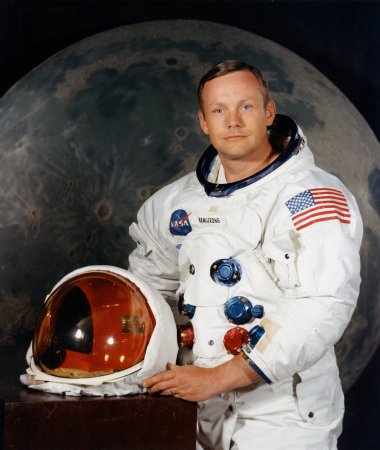Joe Boerner, then US Consul in Sydney cautioned me that interviewing Neil Armstrong was ‘difficult’.
His advice was “talk to him about flying. He loves flying.”
It was good advice but I more or less blew it. It was March 1979 and the Sydney Morning Herald was sending me to Melbourne to talk to the man who was first to stand on the moon on July 20 (US time) in 1969 as he started his second visit to Australia as the lunar attraction at a series of motivational if not secularly fervent sales conferences.

Armstrong was a courteous interviewee. But conscientiously bland.
This is the story that appeared in the SMH on 5 March 1979 as transcribed from my scrapbook since the Fairfax Library bound volumes have been banished to a ware house.
MELBOURNE-Neil Armstrong, first man on the moon, says: “I’m very comfortable in a world where space flight is no longer viewed as spectacular.”
Almost 10 years after taking that “small step for a man, a giant leap for mankind” he is back in Australia. His previous visit was soon after the flight of 1969.
His mission is to talk to businessmen about “motivation” at Sales Conference ’79, a series of conferences in Melbourne, Adelaide, Surfers Paradise and Sydney.
Since Apollo 11’s journey, he has been popularly regarded as a man so altered by the cosmic shock of going to the moon and back, as to have become a recluse.
But Professor Armstrong (he teaches engineering at Cincinnati, Ohio) makes it clear he would rather work than be a popular hero figure.
“I’ve never tried to overtly influence public opinion to my beliefs about space travel,” he said.
“In my work, I’ve tried to point out perspectives for people to take into account, where it counts.
“If space activities are becoming viewed as commonplace, I find that progress.
“We are moving away from exploration into exploitation and that’s probably proper.
“There is a general interest in capturing the advantages of our expertise and getting back some of the investment, but I hope we keep up some exploration.”
While in Australia, Professor Armstrong’s main television viewing will be to pick up reports on the Voyager 1 fly-past on Jupiter and its moons.
The man who was first to see the horizons of another world surround him would not miss a frame of the action.
He talks about flying, in spacecraft, aircraft and gliders, with a precise passion: ” I fly anything I can whenever the opportunity is there.
“When I watch the Space Shuttle doing its drop tests I know that there is the key to the space flights of the future and indeed, I long to fly in it.”
Neil Armstrong doesn’t think the public fits of manic depression by other US space scientists about cutbacks to their programs are necessary.
“I believe space exploration and exploitation will be with us for evermore. It is now a part of human existence,” he said.
“If it is earning its proper place according to the progress it makes and the benefits it brings, I’ll be happy with that.
“I ask no more.”
He is asked about Norman Mailer’s account of the Apollo 11 mission, Of a Fire on the Moon, which seemed to make public so much of the private Neil Armstrong.
“I’ve never read the book, and I’ve never met Mr Mailer,” he says.
But doesn’t Neil Armstrong still feel haunted, perhaps, by the moon in the sky, and find his eyes drawn to that smudge on its surface which represents the Sea of Tranquillity, where he and Buzz Aldrin landed?
“Depending on the phase of the moon, I see individual spots I recall from having been there and working there…yes”
More than opening the spacecraft’s door on another world; more than the first footfall on the lunar surface; that final approach to that great silver field of craters and boulders was Armstrong’s finest memory.
But, when he recalled the moment, the emotion and the essence of the flight were in his eyes not in his brief words.
The first man on the moon, travelling with his wife and youngest of two sons, prefers to avoid publicity in preference to a life working in his chosen field.
I recall having a few words with the sub editors the next day, as they left out a few pars in which Armstrong became more ‘colourful’ almost Maileresque about reaching up to a hanging tab in the Lunar Excursion Module (LEM) after Edwin ‘Buzz’ Aldrin and himself were fully suited up (closed) and ready to go outside.
He said something like, ‘I hesitated. It was opening to door to another world.‘ I was told the pars didn’t fit in with the rest of the copy, which he described as ‘boring.’

Thirty years on Armstrong’s Shuttle is almost at the end of its career, Voyager 1 is so far from the Sun it is lost among the stars, European and Chinese launchers have taken over the commercial space lift game, but the US is the most influential partner by a large margin in multi-national scientific missions including vital research into how the planetary weather ‘engines’ really work.







Crikey is committed to hosting lively discussions. Help us keep the conversation useful, interesting and welcoming. We aim to publish comments quickly in the interest of promoting robust conversation, but we’re a small team and we deploy filters to protect against legal risk. Occasionally your comment may be held up while we review, but we’re working as fast as we can to keep the conversation rolling.
The Crikey comment section is members-only content. Please subscribe to leave a comment.
The Crikey comment section is members-only content. Please login to leave a comment.